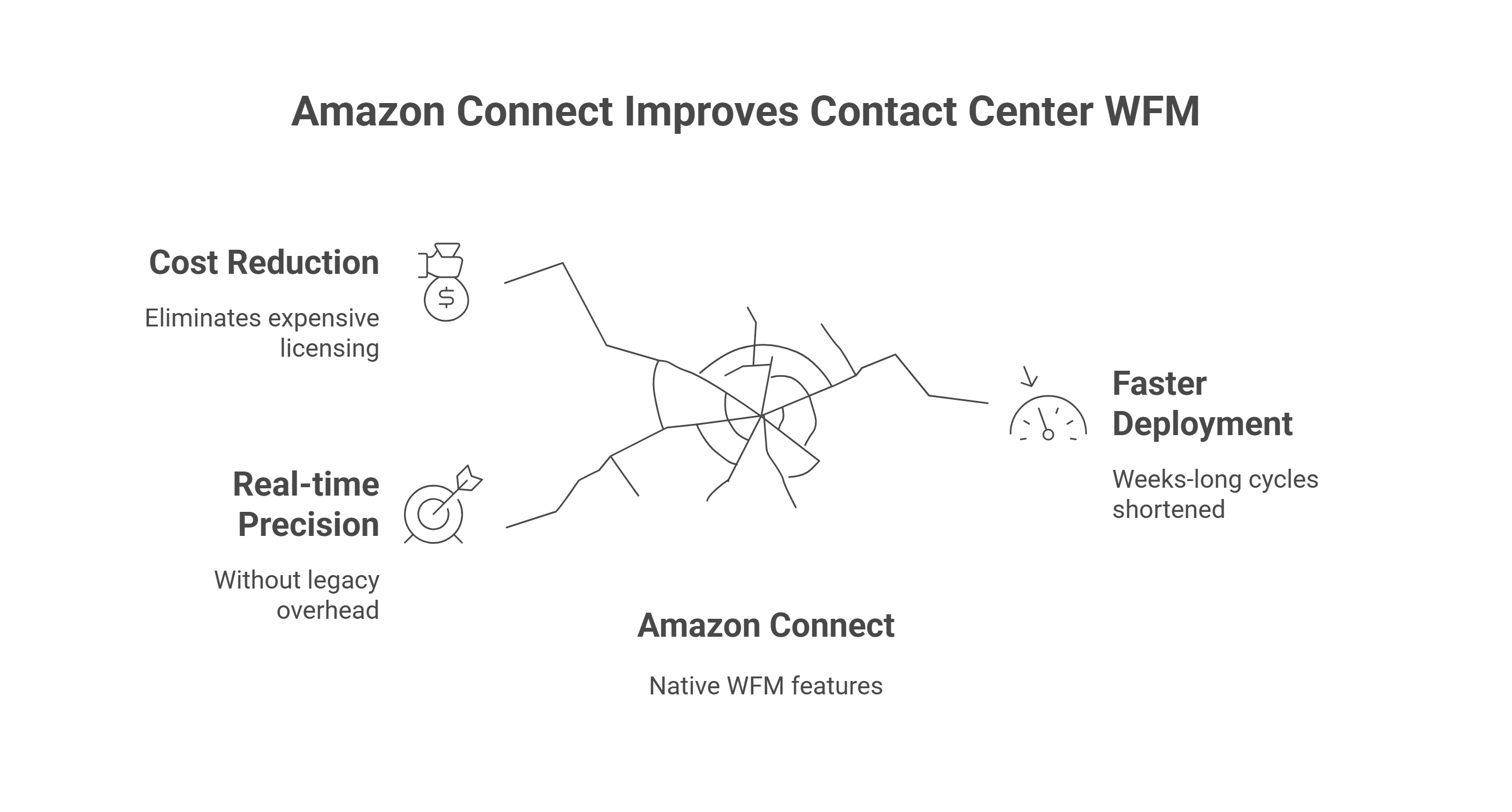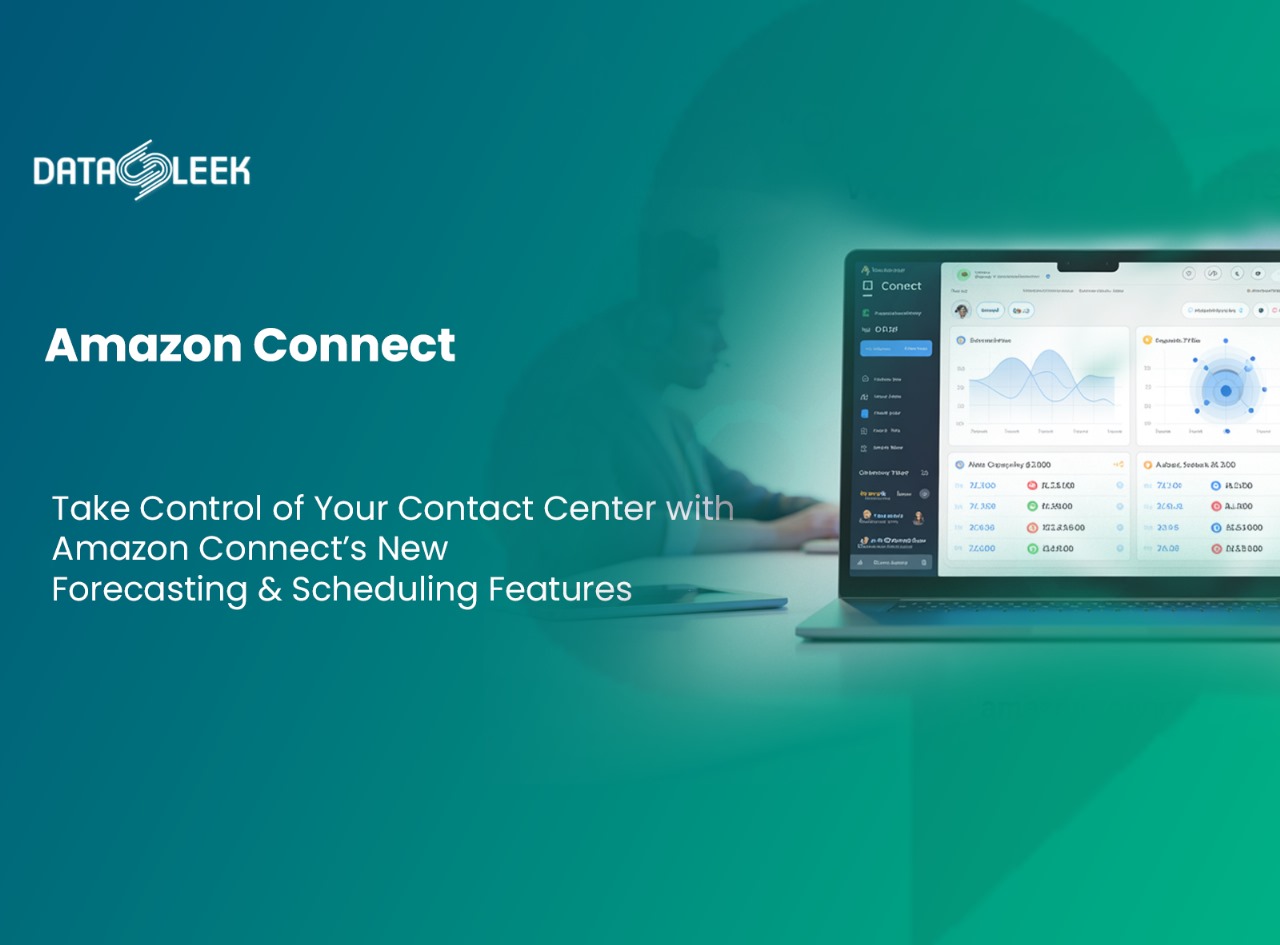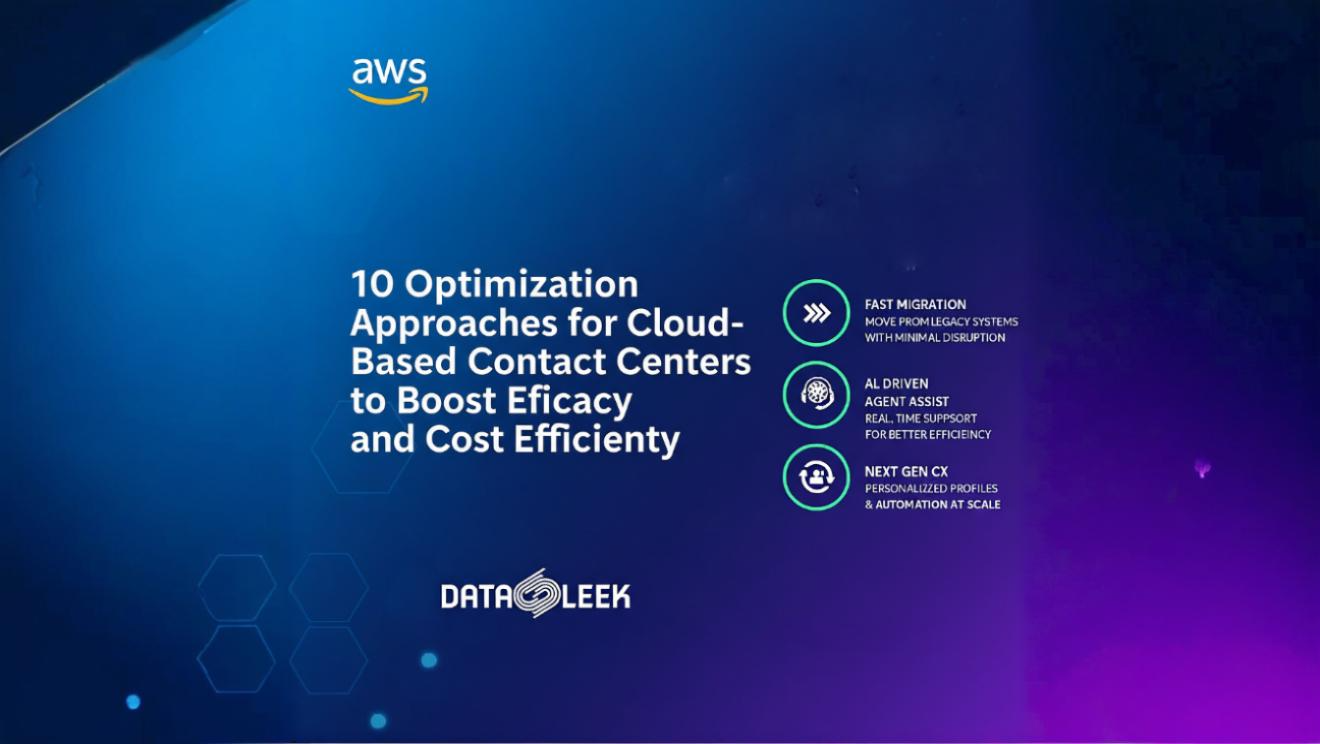Why Forecasting and Scheduling Still Break Contact Centers
If there’s one challenge that has haunted contact centers for decades, it’s workforce management.
Too many agents online and you’re paying for idle time. Too few, and customers wait in long queues, leave frustrated, and churn.
Traditional workforce management (WFM) solutions promise to solve this problem, but they often come with their own baggage:
-
Expensive, complex licensing models
-
Weeks-long deployment cycles
-
A lack of real-time responsiveness to sudden spikes or dips in demand
-
Disconnected data, making accuracy hit-or-miss
This leaves leaders constantly playing catch-up, instead of being in control.
Now, Amazon Connect has taken a major step forward—introducing native forecasting, capacity planning, and scheduling features that give you real-time precision without the overhead of legacy WFM platforms.

What’s New in Amazon Connect Workforce Management
Amazon Connect’s new forecasting and scheduling capabilities are built right into the same platform you already use to handle customer interactions. That means no extra integrations, no data silos, and no disconnected workflows.
Here’s how it breaks down:
1. Smarter Forecasting
Amazon Connect applies machine learning models directly on your historical interaction data to predict demand with high accuracy. Instead of static averages, it accounts for:
-
Seasonal fluctuations
-
Marketing campaigns
-
Unexpected surges (holidays, product launches, outages)
You get a forecast that adapts as conditions change—minute by minute, not week by week.
2. Capacity Planning That Matches Reality
Forecasting is only half the story. You also need to translate that forecast into capacity: how many agents you’ll actually need online, across channels, skills, and time zones.
Amazon Connect does this automatically, giving you:
-
Staffing requirements broken down by interval
-
Multi-skill and multi-channel coverage models
-
Recommendations that update in real time
This means you’re not just guessing—you’re planning with precision.
3. AI-Driven Scheduling
Once you know how many people you need, the platform builds optimal agent schedules. Instead of endless spreadsheets and manual tweaks, you get:
-
Automated schedule creation aligned with forecasts
-
Shift patterns that balance business needs with agent preferences
-
Intraday adjustments when conditions change (for example, if a marketing campaign outperforms expectations)
For agents, this means fairer schedules, better work-life balance, and fewer last-minute surprises. For leaders, it means less firefighting and more control.

Why This Matters More Than Ever
Customers today expect fast, frictionless service—on any channel, at any time. Workforce planning isn’t just about cost optimization anymore; it’s about customer loyalty.
When your contact center runs short-staffed, response times balloon. When you overstaff, budgets bleed. Either way, the business suffers.
By embedding forecasting and scheduling into Amazon Connect, AWS is solving one of the hardest problems in customer experience—without forcing you into another third-party tool or bloated integration.

The Business Impact You Can Expect
Here’s what happens when you move from manual or legacy workforce management to Amazon Connect’s new forecasting and scheduling features:
-
Higher Forecast Accuracy → Fewer staffing mismatches and smoother service.
-
Reduced Operational Costs → Only staff what you need, when you need it.
-
Improved Agent Satisfaction → More predictable schedules and fewer chaotic changes.
-
Increased Customer Satisfaction → Faster resolutions and lower abandonment rates.
-
Future-Ready Scalability → As your business grows, the system scales with you.

How Data Sleek Makes It Work for You
While Amazon Connect provides the foundation, the real value comes from tailoring it to your business model. That’s where Data Sleek steps in.
Our team helps enterprises:
-
Integrate historical data sources (CRM, ticketing, sales systems) for richer forecasting inputs.
-
Design custom capacity planning models tuned to your KPIs.
-
Automate intraday adjustments so your schedules stay resilient under sudden demand shifts.
-
Build reporting dashboards that combine WFM insights with performance metrics like CSAT, AHT, and FCR.
In other words, we help you go from “new features available” to “real business impact delivered.”

Real-World Scenarios Where This Changes Everything
-
E-commerce During Holiday Rush
A retailer can predict demand spikes during Diwali or Black Friday and schedule agents accordingly, avoiding both overstaffing and customer frustration. -
Banking & Financial Services
Banks can handle fluctuating transaction-related inquiries (like tax season or loan applications) without overwhelming their agents. -
Travel Industry
Travel companies can adjust schedules dynamically when sudden weather events or airline disruptions spike call volumes. -
Healthcare Contact Centers
Hospitals and telehealth providers can ensure critical coverage during pandemic surges or vaccination drives.
These scenarios aren’t hypothetical—they’re exactly the kinds of use cases where Data Sleek has already helped clients deploy smarter workforce management with Amazon Connect.

Why Now Is the Time to Act
The reality is, customer expectations aren’t slowing down. Competition is tighter than ever, and the margin for error is shrinking. Every missed call, every delayed chat, every frustrated customer is a hit to your brand.
Amazon Connect’s forecasting and scheduling features finally give you the control you’ve been missing. And with Data Sleek’s expertise, you can deploy them faster, smarter, and with measurable ROI from day one.
Final Word: From Reactive to Proactive
For too long, contact centers have been stuck in a reactive loop—responding to demand after it spikes, scrambling to schedule agents, and firefighting when things go wrong.
With Amazon Connect’s new forecasting and scheduling features, you can break that cycle. You can finally move from reactive firefighting to proactive control.
And with Data Sleek as your partner, you don’t just adopt new tools—you transform the way your contact center runs, scales, and delivers customer experience.
Ready to take control? Let’s build a contact center that predicts, plans, and performs.




